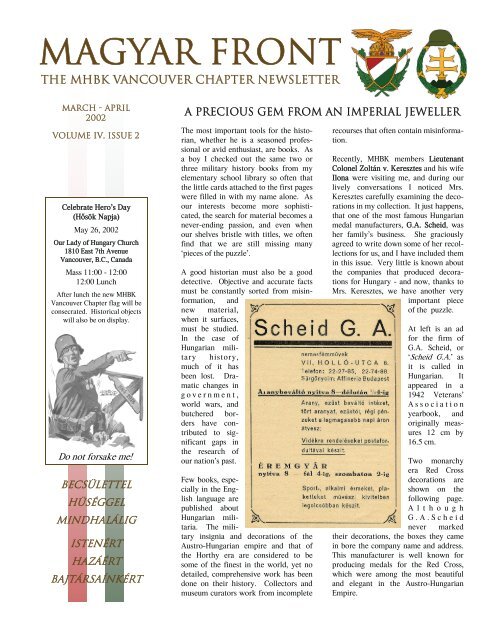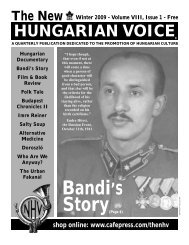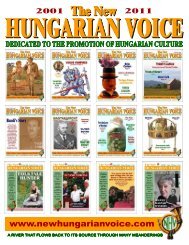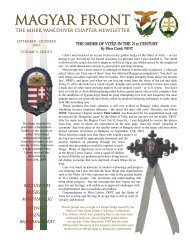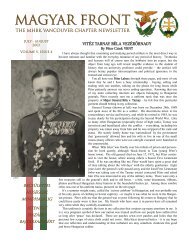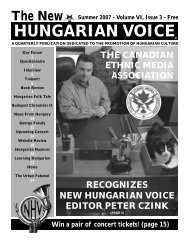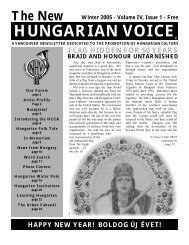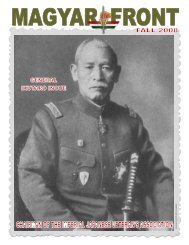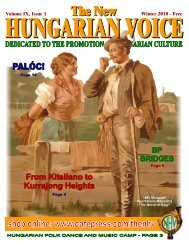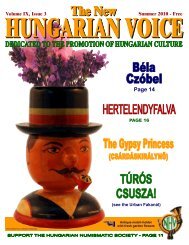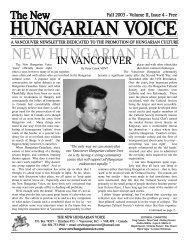MAGYAR FRONT MAR APR 2002 (Read-Only) - new hungarian voice
MAGYAR FRONT MAR APR 2002 (Read-Only) - new hungarian voice
MAGYAR FRONT MAR APR 2002 (Read-Only) - new hungarian voice
Create successful ePaper yourself
Turn your PDF publications into a flip-book with our unique Google optimized e-Paper software.
j^dv^o=colkq=qeb=je_h=s^k`lrsbo=`e^mqbo=kbtpibqqbo=j^o`e=J=^mofi=OMMO=sçäìãÉ=ásI=fëëìÉ=O=Celebrate Hero’s Day(Hõsök Napja)May 26, <strong>2002</strong>Our Lady of Hungary Church1810 East 7th AvenueVancouver, B.C., CanadaMass 11:00 - 12:0012:00 LunchAfter lunch the <strong>new</strong> MHBKVancouver Chapter flag will beconsecrated. Historical objectswill also be on display.Do not forsake me!_b`p§ibqqbi=e§p°ddbi=jfkae^ižifd==fpqbk°oq=e^wž°oq=_^gqžop^ðkh°oq=^=mob`flrp=dbj=colj=^k=fjmbof^i=gbtbiibo=The most important tools for the historian,whether he is a seasoned professionalor avid enthusiast, are books. Asa boy I checked out the same two orthree military history books from myelementary school library so often thatthe little cards attached to the first pageswere filled in with my name alone. Asour interests become more sophisticated,the search for material becomes anever-ending passion, and even whenour shelves bristle with titles, we oftenfind that we are still missing many‘pieces of the puzzle’.A good historian must also be a gooddetective. Objective and accurate factsmust be constantly sorted from misinformation,and<strong>new</strong> material,when it surfaces,must be studied.In the case ofHungarian militaryhistory,much of it hasbeen lost. Dramaticchanges ingovernment,world wars, andbutchered bordershave contributedto significantgaps inthe research ofour nation’s past.Few books, especiallyin the Englishlanguage arepublished aboutHungarian militaria.The militaryinsignia and decorations of theAustro-Hungarian empire and that ofthe Horthy era are considered to besome of the finest in the world, yet nodetailed, comprehensive work has beendone on their history. Collectors andmuseum curators work from incompleterecourses that often contain misinformation.Recently, MHBK members LieutenantColonel Zoltán v. Keresztes and his wifeIlona were visiting me, and during ourlively conversations I noticed Mrs.Keresztes carefully examining the decorationsin my collection. It just happens,that one of the most famous Hungarianmedal manufacturers, G.A. Scheid, washer family’s business. She graciouslyagreed to write down some of her recollectionsfor us, and I have included themin this issue. Very little is known aboutthe companies that produced decorationsfor Hungary - and now, thanks toMrs. Keresztes, we have another veryimportant pieceof the puzzle.At left is an adfor the firm ofG.A. Scheid, or‘Scheid G.A.’ asit is called inHungarian. Itappeared in a1942 Veterans’Associationyearbook, andoriginally measures12 cm by16.5 cm.Two monarchyera Red Crossdecorations areshown on thefollowing page.AlthoughG.A.Scheidnever markedtheir decorations, the boxes they camein bore the company name and address.This manufacturer is well known forproducing medals for the Red Cross,which were among the most beautifuland elegant in the Austro-HungarianEmpire.
THE G.A. SCHEID PRECIOUS METAL WORKS, BUDAPEST - SCHEID G.A. NEMESFÉMMÛVEK, BUDAPESTBy Ilona KeresztesThe company was founded by Mr.Georg Adam Scheid in Vienna aroundthe second half of the nineteenth century.After the 1867 reconciliation withthe House of Habsburg, the industrializationof Hungary began. Mr. Scheidsaw the signs that Budapest would be agood place to expand to, so he lookedover his promising young accountingstaff and selected my grandfather, Mr.Franz Albert Dworak for the job. Theland they bought was on the Pest side,fairly far from the more populated areas;because some chemical activity wasinvolved. My grandfather took a smallcrew of experts with him: Mr. Peitlerthe master smelter; Mr. Henika who didthe alloys and Mr. Neubauer who didthe assaying. I k<strong>new</strong> all of these menwell and called them bácsi, as I alwaysspent part of my summer holidays helpingat the office while I was growing up.Officer’s Cross of Honour of the RedCross with War Decoration.Vöröskereszt tiszti Díszjelvényehadidíszítményel.Gold and silversmiths, dentists, technicians,the Post Office and other big,mostly chemical industries became clients;the factory was a success. Duringthe First World War my grandfatherbecame 50% owner, and after 6 years ofwar and time spent as a Russian prisonerof war my father returned to join themanagement. My mother did also. Wewere a happy and prosperous family,but history stepped in the way againwhen the Anschluss of Austria was declaredin the spring of 1938. My grandfatherdied that summer, and in the fallslirjb=fsI=fpprb=O=Gold embossed ‘G.A. Scheid’company logo from the interior of afitted case for a military decoration.Insignia made by this firm wasrarely marked, and only the decorativeboxes bore the firm’s name and theVienna and Budapest addresses.a lawyer showed up and informed myfather that a percentage of income fromthe factory would have to be turnedover to the Hungarian nazi party. Myfather refused, and this started our family’sCalvary. The media got after uswith the foulest of insinuations and thepolice bothered us month after month.The situation got so bad that we fearedfor our father’s life. Although we werenot Jewish, but we had anti-nazi friendswho were beginning to disappear; rumoursbecame rampant. We had goodfriends in the medical community so myfather was hidden in different hospitalsand my mother bore the onslaught.The factory was declared a ‘second-classwar factory’ and the authorities delegateda war manager. Luckily the mank<strong>new</strong> what was going on and did notinterfere with production. In 1942 thewhole stock of precious metals weremoved to Germany, and from then onwe worked with copper. During thetwo month siege of Budapest the laboratorywas hit with an incendiary bomband it burned to the ground. Our workerswere very loyal and helped with there-building; as payment we carried bagsof potatoes from our garden to them.By the fall of 1945 the factory was inoperation once again.On Good Friday in 1946 a squad of Russiansoldiers, armed to the teeth, weremarshalled in by a squat little major andan interpreter around noon. They de-clared that they were taking over thefactory as a war reparation, as it wasofficially German property. We had tocomply, my father went back into hidingand my mother stayed at the officeto make sure production went on. Our<strong>new</strong> Russian ‘manager’, a fish-salterfrom Murmansk named Elizarof had noidea what we were doing. After sometime however, he became quite civilized;he even took to wearing galoshesover his boots! I was ordered to go tothe Russian commandant to explain (inGerman) what exactly we were doing atthe factory, and my many years of trainingpaid off; the Russians hired both mymother and me. We worked until 1948in the factory office until the Russiansdismantled all of the machinery, took allof the stock and turned over the buildingto the Hungarian authorities. Foryears they tried to find more stock, evenresorting to searching our garden andhouse with metal detectors. We hadenough, and marched out of Hungary in1956.Second Class Cross of Honour of theRed Cross with War Decoration.Vöröskereszt II osztályú Díszelvényehadidíszítményel.m~ÖÉ=O=
What did the firm of G.A. Scheid manufactureand what was its raison d’etre?First and foremost, G.A. Scheid was toprovide the gold and silversmith industrywith world-class quality raw material.Scrap jewellery, silverware, etc. werebrought to the firm to be smelted, afterwhich the final product (gold and silver)was assayed. The owner of the raw materialsremained present during theprocess to ensure that he could be certainthat he was receiving the correctprecious metal content. At this pointthe client was credited with the resultingfine gold or silver, which he couldexchange for specific alloys he was inneed of. A fee was paid for this exchange.We supplied sheet metal and wire atwhatever dimensions the client required.Like many other trades, technicalterminology was German, so whatwas known as Bruch gold was granulatedand refined to 99.7 to 99.8% andthen re-alloyed to whatever karat theclient specified. Refining was a chemicalprocess, supervised by our companyengineer Mr. Bogdandy, or in somecases by the laboratory of the HungarianMint.We also produced gold and silver foilfor industrial purposes. The productionof medals for sports events and art displayswas also a big part of our program.We also served the neighbouringcountries after our former territorieswere returned.G.A. Scheid also owned parts of goldmines to the north of Hungary and Transylvanialost without compensation afterthe Treaty of Trianon. The firm was oneof the few refineries in Eastern Europeand had an excellent international reputation.After the Second World War, the HungarianMint took over what little demandwas left of the gold and silvermanufacturing industry. In Vienna theGerman giant Degussa bought out G.A.Scheid’s affiliate and the old and honouredname went down in history rememberedby collectors of medals thatbear the venerated name.slirjb=fsI=fpprb=O=SOME OF THE OTHER JEWELLERS OF THEAUSTRO-HUNGARIAN EMPIREANDRE ALCKENS, FAUBOURGKnown to have produced embroidered breast stars of the Hungarian Order of St.Stephen and the Austrian Order of the Iron Crown.A. BACHRUCH, VIENNASpecialized in lower grades of the Order of Franz Joseph and Red Cross insignia.BECK, VIENNAK. BOHM, VIENNABelieved to have made Hungarian Orders of St. Stephen, and other decorations.F. BRAUN, VIENNAA small firm, this company also made specimens of the lower grades of the Order ofFranz Joseph.KARL FISCHMEISTER, VIENNASpecialized in the orders of Serbia from the 1880’s until the First World War. Thisfirm’s hallmark was “K.F.” They produced the Romanian Order of the Crown, and thehallmark “J.R.F.” was used on pieces that were subcontracted to the firm of Resch inBucharest.JOHANN HOLLAUER, VIENNAA. KITTNER, VIENNAAnother minor jeweller also involved with the lower grades of the Order of FranzJoseph.A. E. KÖCHERT, VIENNAFounded in 1814, this firm is still operating today. They produced all of the imperialAustrian orders, and some jewelled insignia.WILHELM KUNZ, VIENNAMade many of the lower grades of Austro-Hungarian orders, this company usuallymarked their name or “W.K.” on their ribbon rings.JOHANN MAURER, VIENNA - SOPRONThis firm also had a branch in Sopron, Hungary, and specialized in many orders anddecorations.VINC. MAYER’S SÖHNEWas one of the more famous imperial jewellers. They made all of the orders and decorationsof Austria-Hungary, as well as Papal and German orders. This firm beganaround the 1860’s and continued through World War I. Their workmanship was excellent,and often bore a ‘V.M.” hallmark.MORZSÁNYI JÓZSEF DÍSZMÛKÉSZÍTÕ, BUDAPESTANTON REITTERER, VIENNAReitterer continued making decorations for Austria after W.W.I, and produced theOrder of St. Stephen during the Horthy era. They are still in business.GEBRÜDER RESCH, VIENNAAside from manufacturing all of the imperial Austro-Hungarian insignia, they also pro-m~ÖÉ=P=
duced medals and insignia for Montenegro and Papal orders. “Gebr. Resch” is oftenstamped on their decorations.EDWARD RIEMER, PRAGUEC.F. ROTHE & NEFFE, VIENNAFounded in 1830, this jeweller was one of the largest and most famous in the Austro-Hungarian Empire, and in fact all of Europe. In 1849 the factory moved to its currentlocation – they still produce fine jewellery and decorations. They were known as theHofjuwelier to the House of Habsburg and made insignia for many countries includingGermany, Mexico, Tunisia, China, Persia, Sweden, Turkey, The Netherlands, Montenegro,Italy, Spain and the Vatican. They were famous for jewelled insignia whichincluded the diamond crown for the coronation of Empress Elizabeth and a jewelledcross for the Cathedral of Sofia in Bulgaria.ROZET & FISCHMEISTER, VIENNAA. SCHARF, VIENNAJOHANN SCHWERDTNER, VIENNARUDOLF SOUVAL, VIENNAUntil the end of W.W.I this firm made smaller items, but then began to made orders forthe Austrian Republic before W.W.II. They also produced insignia for Romania andGreece. During the Second World War they made many German insignia as well assome Hungarian orders, and used the hallmark “R.S.” or “L/58”. After W.W.II theymade insignia for the American, British, French and Russian armies, and from 1950 forthe <strong>new</strong> Austrian government.MORITZ TILLER & COMPANY, VIENNAJ. WIEDLICH, VIENNAREMEMBERTRIANON!June 4th is the 82ndanniversary of one ofHungary’s greatest tragedies.Send for your Trianon lapel pinon black ribbon(shown above actual size)$3.00 CDN or $2.00 US each(postage included)PÉTER CZINK VRNTP.O. Box 745272803 West 4th AvenueVancouver, B.C. V6K 4P4CanadaA TRADITION BORN IN AN ERA OF CARRAIGESAND KINGS - CARRIED ON BY THE MHBKIn today’s modern world it’s easy to overlook the ‘pedigree’ of ourorganization. In 1967 the MHBK’s 20 Year Commemorative Medalwas struck - its design based on that of the familiar Horthy Era‘Signum Laudis’. At right is the medal shown actual size. TheMHBK insignia and the years ‘1947-1967’ are on the obverse, whilethe reverse bears a miniature rendition of the ‘Fire Cross withWreath and Swords’ or Tûzkereszt koszorúval, kardokkal and thewords: BECSÜLETTEL ÉLÜNK ÉS HALUNK (With honour we live andwith honour we die). This medal is of the finest quality, die-struckwith a separate two-piece crown.It is complete with its original case, made just like the ones fromthe imperial era, and is shown at left. On the outside of the lidof this fine case is a gold embossed stylized Hungarian crown;and embossed in the white lining of the lid’s interior is:C.F. ROTHE, WEINKOHL<strong>MAR</strong>KT No. 7...the famous jeweller’s address since 1849.slirjb=fsI=fpprb=O=m~ÖÉ=Q=
objbj_bofkd=lro=ollqpW=qeb=erkd^of^k=colkqJifkb=cfdeqboÛp=jlsbjbkq=DR. ANTAL ULLEIN-REVICZKYI recentely purchased the insignia shown below (reproduced three-quarters actual size) - the shoulder strapsand collar badges that belonged to Dr. Antal Ullein-Reviczky. A few of the top leaders of the Front-LineFighter’s Movement wore this type of insignia, although the backing colour on the shoulder straps were white.It is believed that this combination was unique to Ullein-Reviczky, and these examples are the only ones knownto exist. The photo below, from a 1942 yearbook clearly shows him wearing them with his Veterans’ Associationuniform. He also wears general’s insignia on the side of his cap.Ullein-Reviczky was co-president of the Front-Line Fighter’s Association, the Chief Press Officer of the ForeignMinistry and later the Ambassador to Sweden. This highly decorated officer and professor of international law didhis best to keep Hungary out of the Second World War, as he foresaw the terrible situation his country was headedtowards. The following is an interesting anecdote referring to Hungary’s hesitance in declaring war on the UnitedStates:“The latter can be illustrated best by pointing to a speech of Senator John Barkley, who chided Hungary for not resistingthe Germans, and threatened the country with the possible loss of its independence after the war as a punishment.The answer to Senator Barkley’s unfriendly words came eventually through American diplomatic channels fromUllein-Reviczky in Stockholm. Deprived of his ambassadorship and citizenship because of his anti-German statementsand criticism of the German occupation of Hungary, he pointed out in a letter to the Senator that Hungarywas already deprived of its independence, and it was hoping to have that independence restored after the war by thevictorious Western Allies.”In 1947 he wrote Guerre Allemande, Paix Russe (German War, Russian Peace) which wasre-published in 1993 in Budapest by Europa Publishers as Német Háború, Orosz Béke. Interestingly,Ullein-Revicykz’s wife was English.The ‘<strong>MAGYAR</strong> <strong>FRONT</strong>’ Is published bi-monthly by Peter Czink VRNT,Chapter Leader, Vancouver Chapter, Hungarian Veterans’ Association (Csoport vezetõ, Vancouveri csoport, Magyar Harcosok Bajtársi Közössége)P.O. Box 74527 • 2803 West 4th Avenue • Vancouver B.C. • Canada • V6K 4P4telephone/fax: (604) 733-9948 • email: czink@shaw.ca


